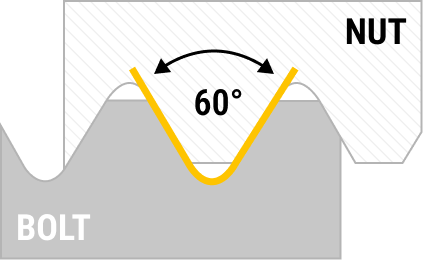
UNR Thread (USA)
The UNR thread is a variation of the standard UN thread, differing in only one respect: the UNR thread has a rounded thread root, while the UN thread is flat. Otherwise, both thread types are identical.
Fully written out, the designation for the UNR thread is "Unified National Thread Series with external thread controlled root radius." From this term, two things can be inferred:
1. The standard for the UNR thread refers only to external threads ("external thread"), there are no UNR internal threads. Instead, a regular UN thread is used for internal threads.
2. The special feature of the UNR thread is the "controlled root radius," i.e., the radius at the thread root. This is always between 0.108 times and 0.144 times the pitch.
This complex modification of the UN profile was developed in the 1950s. The rounded thread root provides a higher fatigue resistance for the UNR thread, making it suitable for mechanically demanding tasks and ensuring safety in critical areas.
The UNR thread, like all Unified National threads, is controlled by the American National Standards Institute (ANSI) and is standardized according to ANSI/ASME B1.1. It is an inch-based thread with a flank angle of 60°.
The thread designation for the UNR thread consists of three components. First, the external diameter in inches is mentioned, followed by the pitch and the acronym UNR, e.g., 7/16" – 16 UNR. The dimensions of the UNR thread are identical to those of the UN thread.
To fully understand the thread table of the UNR thread, basic knowledge of the UN thread is necessary. This is a series of thread standards with a constant pitch. These are depicted in separate tables according to the number of threads per inch. However, in the UNR thread, all possible variants per pitch are summarized in a single table. This leads to the situation where the same external diameter with different pitches is found several times in the UNR thread table.
In the table below for the UNR thread, we list both the inch measurements for diameter and pitch and their corresponding mm values. Additionally, we have included the required core hole diameter for each thread size if you need to cut a UNR thread yourself.
